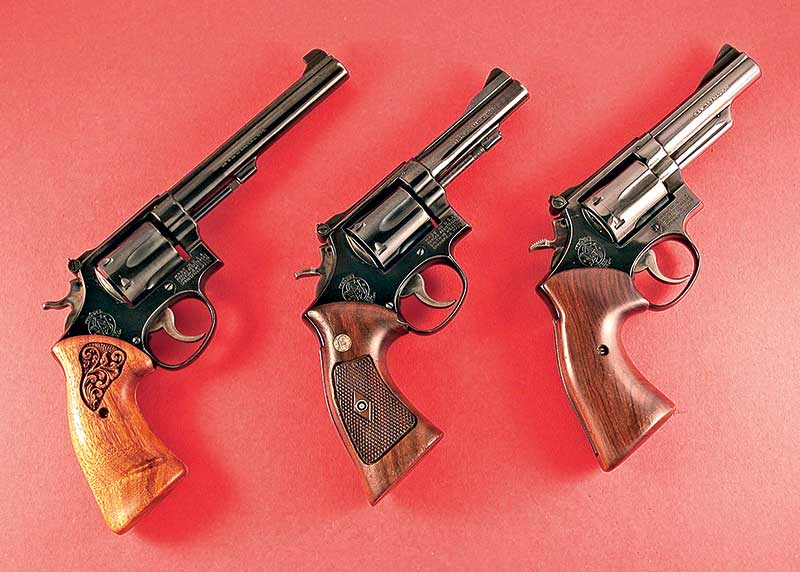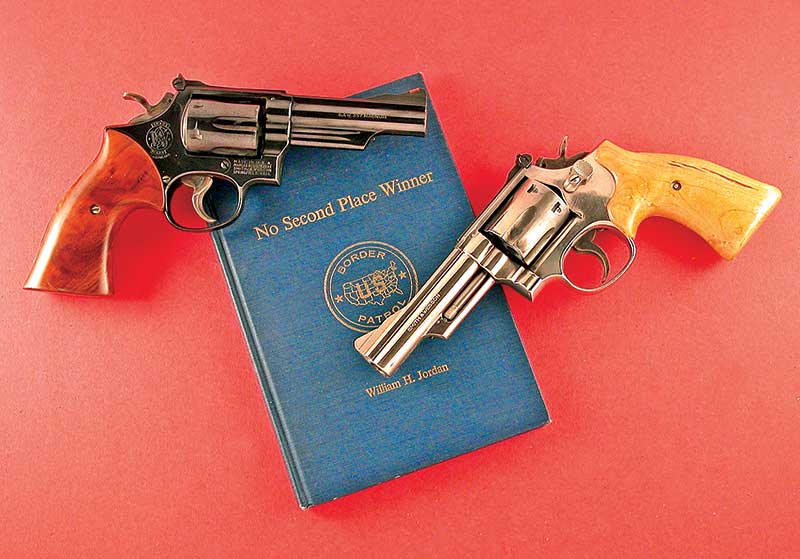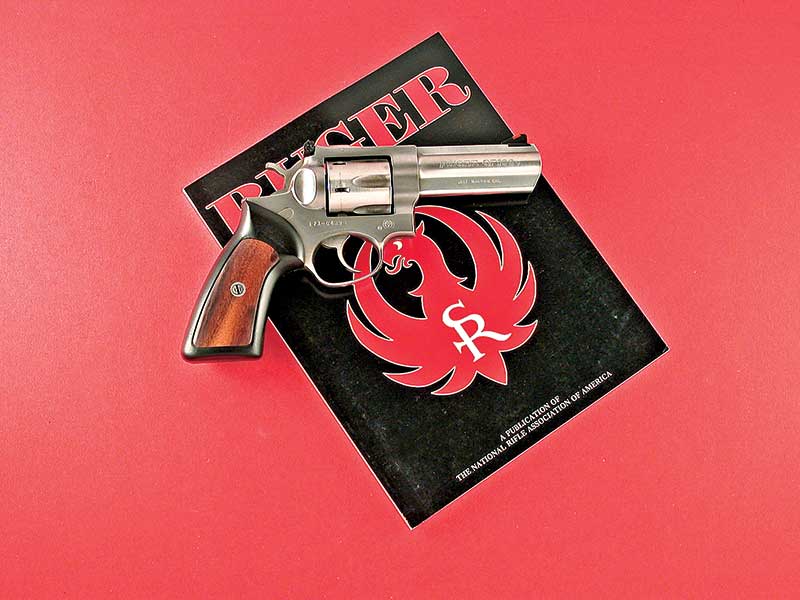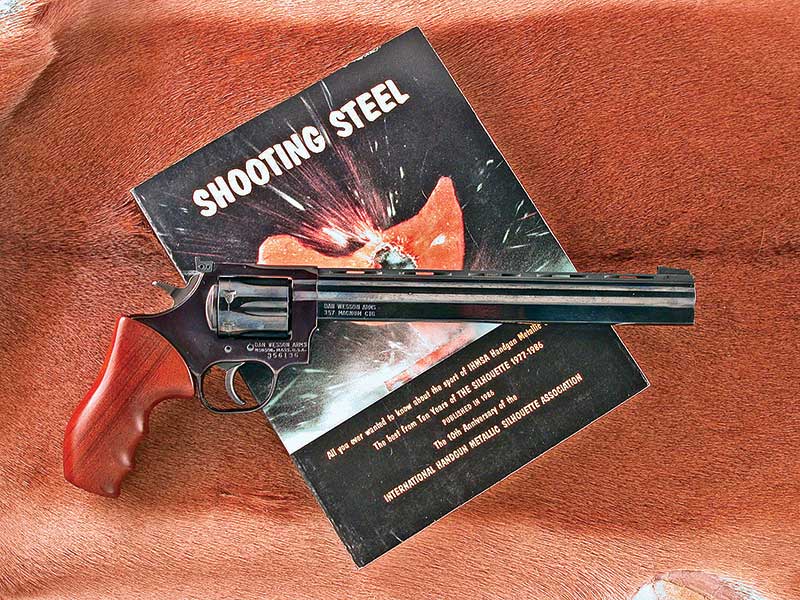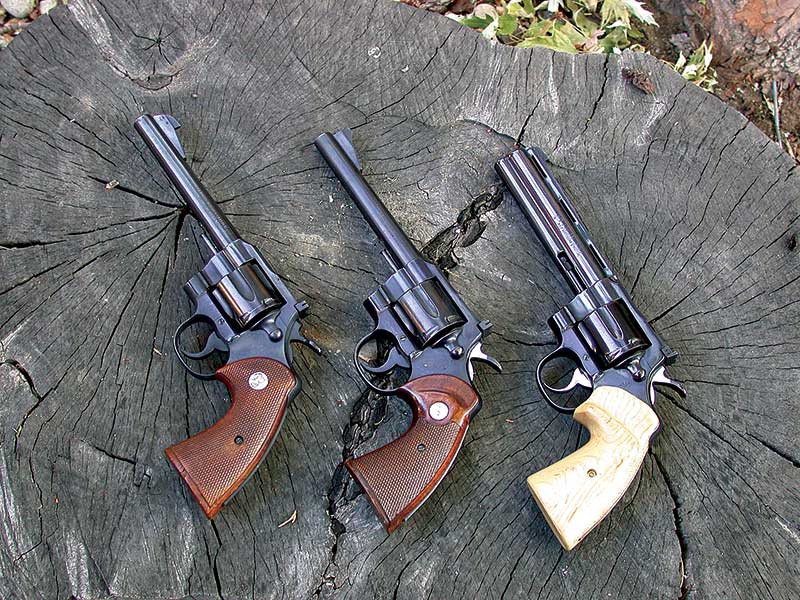.357 Magnum DA Sixguns
Still Elegant After All These Years
Elmer Keith was instrumental along with Phil Sharpe in laying the groundwork for the .357 Magnum by using heavy loads in the .38/44 Heavy Duty, an N-Framed .38 Special which arrived in 1930. Keith tested a .357 Magnum in 1935, however, he did not particularly care for the long barrel nor the fact his #358429 bullet was too long for use in .357 Magnum brass in the relatively short cylinder of the S&W .357 Magnum. His solution was to use .38 Special brass and his bullet over 13.5 grains #2400. Over the years I do believe I have shot this load in .357 Magnum double and single action sixguns more than any other. It’s a very warm load and clocks out at 1,430 fps in one of my 83/8″ .357 Magnums.
I never saw a single S&W .357 Magnum for sale during the 1950’s. Skeeter Skelton related how tough it was for him to come up with one after he joined the border patrol, however when he was successful he related the 5″ version was his favorite. I also like the 5″ and it makes an excellent compromise between the 31/2″ .357 Magnum — which remains to this day as the deadliest looking sixgun ever produced — and the hard to carry but easy to shoot 83/8″ version. Smith & Wesson revolvers had names until 1957, when they all acquired model numbers and the .357 Magnum became the Model 27. I prefer the old names.
Over the past half century or so I’ve shot all barrel lengths extensively, however when I pick favorites I’m going to do it with my heart and go with two pre-Model 27’s I’ve acquired over the years. These unnumbered models of the .357 Magnum have 61/2″ and 83/8″ barrels. They have been further enhanced by period style stocks from Keith Brown. The latter wears Magna-style, or as Keith called them, plainclothes grips, while the shorter version wears carved Roper grips.
Walter Roper designed the original S&W stocks in the 1930’s and these were later modified to what is now known as the Skeeter Skelton Style. I barrel which I like every much; it’s also a favorite .357 Smith. Then there is the 31/2″ Model 27 with Roy Fishpaw grips. Lots of choices make decisions tough.
Another favorite of mine is the bargain-basement .357 Magnum from Smith & Wesson, the Highway Patrolman. Especially designed for heavy-duty use by outdoorsmen and law enforcement, the Highway Patrolman is nothing more than a matte blue finished .357 Magnum without the beautiful checkering on the barrel rib. These guns were offered in both 4″ and 6″ versions, and while I could not find an original .357 Magnum I did purchase a 4″ Highway Patrolman Model 28 in 1957. It was the first new centerfire double-action revolver I had ever purchased and it was also the first centerfire sixgun Diamond Dot ever shot. I sold that original Highway Patrolman to my cousin in the 1960’s but it has since been replaced and also sided by a 6″ pre-28.
The Model 19
In 1955, Chief Border Patrol Inspector Bill Jordan convinced S&W to come out with an easier to carry .357 Magnum and the result was the Combat Magnum now known as the Model 19. S&W started with their Military & Police .38 Special, specially heat-treated the frame, added a .357 Magnum cylinder and a bull barrel with an enclosed ejector rod. The result was what Bill called “a peace-officers dream.” Carrying a .357 Magnum all day became much easier with the K-Framed version weighing a half pound less than the original .357 Magnum. I have hiked many miles in the hills carrying a much appreciated Combat Magnum.
In the heyday of Bullseye shooting Colt had the target shooter’s first choice in revolvers with the Officers Model Match .38 Special. In 1954 this same basic revolver became the .357 Magnum, and then one year later, the Python emerged. To come up with the beautiful Python, Colt added a heavy underlugged barrel with a ventilated rib to the .357 Magnum, hand honed the action, and finished it in what was then known as Colt Royal Blue. Those original Pythons had 6″ barrels and when a 4″ version was introduced I lusted over that sixgun as I have never done before or since. When I finally did get one I was very disappointed as I could not shoot it very well; it just didn’t balance right for me. Adding an 8″ barrel changed everything, and it’s now one of my favorite, and most accurate sixguns.
Dan Wesson And Ruger
In the 1970’s and 1980’s, two more .357 Magnum sixguns emerged. Dan Wesson jumped into the Long Range Silhouette game and soon offered a 10″ heavy underlugged barrel .357 Magnum with excellent sights coupled with superb accuracy. Targets, especially rams, could be stubborn when it came to knock down, however I soon found loading 180 and 200-gr. bullets in .38 Special cases at around 900 fps made a near perfect combination. It seemed to take forever for this load to arrive at the 200-meter rams, however it never failed to take them down.
Ruger got into the .357 Magnum double action business with the Security-Six. After producing over a million of these it was dropped in favor of the GP-100 which is probably the most rugged, virtually indestructible .357 Magnum double-action sixgun ever offered. No one can go wrong purchasing a GP-100 as a first sixgun. If I had to carry a .357 Magnum all day in all kinds of weather and rough conditions I could easily choose a GP-100 and know it would never let me down.

